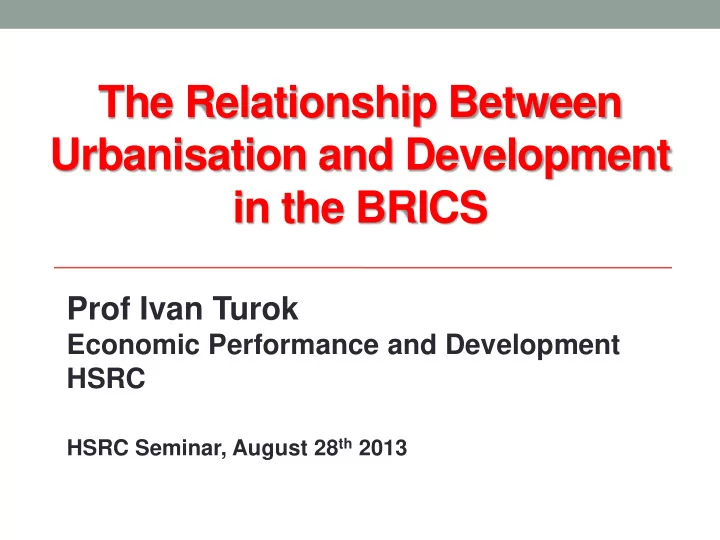

The Relationship Between Urbanisation and Development in the BRICS Prof Ivan Turok Economic Performance and Development HSRC HSRC Seminar, August 28 th 2013
Context Continuing large-scale urbanisation in South 1. Deep ambivalence in many countries 2. Partly ‘cos seen as a demographic issue 3. Others see it mainly as social/rights/justice 4. Need to link it to (economic) development 5. Different elsewhere – eg China 6. Significance of the BRICS : not just an acronym 7. • 42% of world population; 26% of global production; 47% of world output growth in last decade. Dramatic pol. transitions. • Symbolic & political importance – new feature of global integration, new development paradigm? • Any lessons for South Africa? 2
Outline Urbanisation and development in theory 1. The context of the BRICS 2. China, India, Brazil, Russia, SA 3. Some lessons 4. 3
The new conventional wisdom “Countries that are highly urbanised tend to have higher incomes, more stable economies, stronger institutions and are better able to withstand the volatility of the global economy” (UN, 2007) “The city is one of the highest pinnacles of human creation … cities have the power to innovate, generate wealth, enhance quality of life and accommodate more people within a smaller carbon footprint” (UN-Habitat, 2012)
The possible relationship between urbanisation and development 1. Coincidental 2. Urbanisation an effect of industrialisation 3. Urbanisation contributes to development 1. Efficient production by concentrating resources 2. Stronger consumption 3. Entrepreneurial dynamism 4. Creativity and innovation 5. Infrastructure and services
6 The rediscovery of cities: theory Industrial Technology, Green Globalisation transition knowledge transition Agglomeration Productivity advantages: size, and innovation density, diversity … Population = Jobs and labour & incomes consumers
7 Possible negative externalities Globalisation: Climate change: Competition, immigration Risk of disasters Agglomeration Lower disadvantages: productivity congestion, high costs Population = Stagnation, overcrowding, lower taxes social tensions
The context of the BRICS, 1985-2011
Asia 1985-2011
South America 1985-2011
Africa 1985-2011
Life expectancy, 1985-2011 95 Argentina Uruguay Venezuela Chile 90 85 80 Peru Mexico Brazil 75 Panama Percentage Urbanisation 70 Ecuador Colombia 65 60 65 55 Jamaica South Africa 60 50 55 Paraguay 45 50 40 Percentage Urbanisation 45 Cameroon 35 Ghana Liberia 60 65 70 75 80 40 Life Expectancy 35 Nigeria Madagascar Guinea Zimbabwe 30 -Bissau 80 Republic of Korea 25 70 Kenya 20 Malaysia Ethiopia 15 60 Percentage Urbanisation 10 Fiji Uganda China Malawi 50 5 Philippines 0 40 Thailand 40 45 50 55 60 65 Indonesia Vietnam Life Expectancy 30 Source: World Development Indicators 20 10 0 55 60 65 70 75 80 85 Life Expectancy
China Anti-urbanisation until 1980s, pro-rural 1. Remarkable industrial transition - state-driven 2. Explosive growth & poverty reduction 3. Shift from rural industrialisation to export-led 4. growth based on coastal cities Rural-urban migration depressed labour costs 5. Local experimentation & incentives via land 6. Financed major infrastructure & building progs 7. Devolution to municipalities and mergers 8. 13
China (2) Speculation, corruption, illegal construction, 1. land grabs, fast-track procedures Residence permits (hukou) discriminate 2. against rural migrants – inferior housing and services, divisive, insecurity Environmental degradation, pollution, 3. inefficient use of resources Regional divisions 4. Rebalancing, consumer-spending …? 5. 14
India Colonial legacy of poorly integrated country, 1. backward economy, inefficient bureaucracy Segregated cities for the few, slum clearance 2. Post-1947 independence state controls and 3. investment in industry and infrastructure 1991 liberalisation reforms – urban economic 4. growth, new middle class, IT service industries Global city ideas vs other cities 5. Amenities, segregation, exclusion 6. Decentralisation favours urban elites 7. Massive rural poverty 8. 15
Brazil Colonial legacy of poorly integrated country 1. State-sponsored industrialisation (import- 2. substitution) from 1930s caused urbanisation Self-reinforcing dynamic gathered pace 3. State investment in transport, communications 4. and industrialisation bolsters urbanisation Anti-urban policies from 1960s – restrictions 5. Makeshift settlements in hazardous locations 6. Late 1980s new urban policy, democracy, 7. decentralisation, innovation Practical progress complicated and slow 8. 16
Russia Large-scale state-driven industrialisation & 1. urbanisation based on heavy industries - 1920s Reinforced by collectivisation of agriculture 2. Specialisation: single industry cities for military- 3. industrial complex and basic consumer goods Centralised planning dispersed jobs and popn 4. Disintegration of Soviet Union in 1990 exposed 5. cities and industries to market forces Losers – industrial cities in N and E 6. Winners – Moscow and some others in W & S 7. 17
South Africa Mining and industrialisation drove urbanisation 1. from late 19 th century Based on cheap labour, circular migration, 2. compounds, distorted urban form Post-was anti-urbanisation and oppressive 3. controls, segregation, exclusion, removals Narrow ideology vs economic imperative 4. 1980s collapse and crisis, urbanisation rebound 5. Physical and psychological legacy 6. Ambivalence towards urbanisation, complicated 7. transformation 18
19 Trends in employment 150 140 Total Metros 130 Percentage Total 120 Secondary Cities 110 Rest of South Africa 100 90 1996 1997 1998 1999 2000 2001 2002 2003 2004 2005 2006 2007 2008 2009 2010 2011 2012 Year Source: IHS Global Insight
20 Employment growth 1996-2012 Total Metros 14.5% 10.6% Total Secondary 74.9% Cities Rest of South Africa Source: IHS Global Insight
Better alignment: population versus jobs growth (2001-2011)
South Africa’s experience New policy initiatives: • National Development Plan • Integrated Urban Development Framework • City Support Programme • National Upgrading Support Programme
Lessons 1. Industrialisation powerful driver of urbanisation 2. Urbanisation can help fuel the process 3. More effective with productive, healthy, stable workforce and active consumers 4. Other mechanisms (enterprise, innovation) are slower and weaker 5. Key role for access to land, infrastructure, efficient urban forms, pro-active planning of the built environment, reinvestment from growth
24 Thank you!
Recommend
More recommend